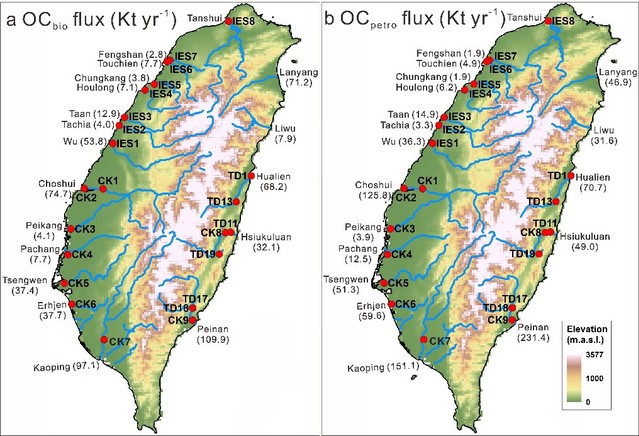Baozhi Lina, Zhifei Liua*,Timothy I. Eglintonb*, Selvaraj Kandasamyc, Thomas M. Blattmannb, d, Negar Haghipourb, e, Kuo-Fang Huangf, Chen-Feng Youg
a State Key Laboratory of Marine Geology, Tongji University, Shanghai 200092, China
b Geological Institute, ETH Zürich, Zürich 8092, Switzerland
c Department of Geological Oceanography and State Key Laboratory of Marine Environmental Science, Xiamen University, Xiamen 361102, China
d Biogeochemistry Program, Japan Agency for Marine-Earth Science and Technology, Yokosuka 237–0061, Japan
e Laboratory of Ion Beam Physics, ETH Zürich, Zürich 8093, Switzerland
f Institute of Earth Sciences, Academia Sinica, Taipei 11529, Taiwan
g Department of Earth Sciences, National Cheng Kung University, Tainan 70101, Taiwan
Corresponding authors:
E-mail address: lzhifei@tongji.edu.cn (Z. Liu); timothy.eglinton@erdw.ethz.ch (T.I. Eglinton)
Abstract:
Oceanic islands in the western Pacific export ~35% of particulate organic carbon (OC) to the world ocean, but composition and age of OC varies dramatically among and within the islands. Understanding island-wide variation in sources and controls on the sedimentary OC in a series of rivers is therefore essential to assess the role of oceanic islands on the global carbon cycle. Stable and radioactive carbon isotopic compositions of sedimentary OC in 17 rivers across Taiwan indicate various proportions of biospheric OC derived from soil overlain by C3 and C4 vegetation and petrogenic OC from sedimentary and metamorphic rocks. Higher fractions of biospheric OC occur in sediments of northwestern rivers, while petrogenic OC is dominant in southern river sediments. Vegetation type, lithological setting, and sediment yield in river basins largely control island-wide OC compositions in river sediments. Considerable differences in export fluxes of biospheric and petrogenic OC based on different provenance proxies exist for individual rivers, highlighting the need for additional radiocarbon measurement (with high sample frequency) to better understand the role of oceanic islands in the global carbon cycle.
Full Article: https://authors.elsevier.com/a/1aoMY,Ig4Kppr



